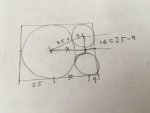You are using an out of date browser. It may not display this or other websites correctly.
You should upgrade or use an alternative browser.
You should upgrade or use an alternative browser.
Circles: Three circles fit inside rectangle as shown....
- Thread starter sojeee
- Start date
- Joined
- Apr 12, 2005
- Messages
- 11,339
View attachment 9343 Three circles fit inside rectangle as shown.
Two of the circles are identical and the third is larger.
The circles have radii 9cm, 9cm and 25cm.
Calculate the lengh, l, of the rectangle.
I'm not going to suggest a solution, since you have shown no work, but I will suggest that you draw 11 different radii. I won't tell you which ones. Maybe it will lead you somewhere. Let's see what you get.
Last edited:
I'm not going o suggest a solution, since you have shown no work, but I will suggest that you draw 11 different radii. I won't tell you which ones. Maybe it will lead you somewhere. Let's see what you get.
could you please explain what you mean by 11 different radii
- Joined
- Feb 4, 2004
- Messages
- 16,583
Which part do you not understand? Please be specific. Thank you!could you please explain what you mean by 11 different radii
Dr.Peterson
Elite Member
- Joined
- Nov 12, 2017
- Messages
- 16,059
could you please explain what you mean by 11 different radii
A radius, in the sense intended by tkhunny, is a segment from the center of a circle to its circumference. In your picture, there are 11 places where you can do this, from the center of a circle to a point shown on the picture. For example, there are 5 points on the large circle where it touches something.
If you draw these 11 radii, labeling them with their lengths, you should be able to write an equation or two with which you can find lengths of parts of the rectangle. The Pythagorean theorem will be particularly useful.
Give that a try, and let us know your results. Keep in mind that we tend to be much more helpful when you show work, which helps us know what help you need.
A radius, in the sense intended by tkhunny, is a segment from the center of a circle to its circumference. In your picture, there are 11 places where you can do this, from the center of a circle to a point shown on the picture. For example, there are 5 points on the large circle where it touches something.
If you draw these 11 radii, labeling them with their lengths, you should be able to write an equation or two with which you can find lengths of parts of the rectangle. The Pythagorean theorem will be particularly useful.
Give that a try, and let us know your results. Keep in mind that we tend to be much more helpful when you show work, which helps us know what help you need.

The yellow part is what I cannot figure out
Dr.Peterson
Elite Member
- Joined
- Nov 12, 2017
- Messages
- 16,059
View attachment 9344
The yellow part is what I cannot figure out
I wouldn't draw the yellow line at all. The length you need to find can be seen as the altitude of a right-angled trapezoid with sides 25, 25+9, and 9. If you draw another line in there, you will be able to use Pythagoras.
I wouldn't draw the yellow line at all. The length you need to find can be seen as the altitude of a right-angled trapezoid with sides 25, 25+9, and 9. If you draw another line in there, you will be able to use Pythagoras.
Could you please direct me as to where to draw this extra line in the trapezoid
Dr.Peterson
Elite Member
- Joined
- Nov 12, 2017
- Messages
- 16,059
Could you please direct me as to where to draw this extra line in the trapezoid
The mention of the Pythagorean theorem is a major hint. How can you make a right triangle, two of whose sides you know?
Additional hint: the length of this line will be the missing part of the length L.
The mention of the Pythagorean theorem is a major hint. How can you make a right triangle, two of whose sides you know?
Additional hint: the length of this line will be the missing part of the length L.
Thankyou for the help I have worked it out and got 64cm in total
Dr.Peterson
Elite Member
- Joined
- Nov 12, 2017
- Messages
- 16,059
Thankyou for the help I have worked it out and got 64cm in total
That's right, so I assume you found the right triangle.
This trick is used in many geometry problems involving either circles or trapezoids; for example, it is used to find the length of a common tangent between two circles. Part of the reason for giving only hints is to help this way of thinking become more memorable for you!
do you know how to find x?

View attachment 9343 Three circles fit inside rectangle as shown.
Two of the circles are identical and the third is larger.
The circles have radii 9cm, 9cm and 25cm.
Calculate the lengh, l, of the rectangle.


